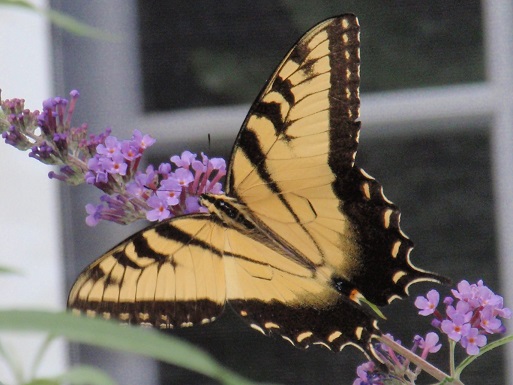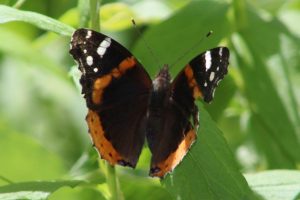 Summer is the time of butterflies and moths. Any sunny day, these sprites can be seen visiting our garden. As I learned the common and scientific names, I became curious as to how these insects received their names. More than 380 years ago, Carl Linnaeus overturned the naming system for plants and animals. In his day, he named over 11,000 species. How did he decide on names? We cannot ask him. He left very few clues, so one must attempt to read his mind by rooting through his records and attempting to find a pattern or key that opens up his thinking. In this blog, I will struggle through his early classification of insects and in particular to butterflies and moths.The challenge for me was to understand a Swedish naturalist who wrote in Latin, two languages I do not understand. Therefore, all you read may be totally wrong, but I would not put my neck out like this is I did not feel some level of confidence. I used a Latin to English web based translator.
Summer is the time of butterflies and moths. Any sunny day, these sprites can be seen visiting our garden. As I learned the common and scientific names, I became curious as to how these insects received their names. More than 380 years ago, Carl Linnaeus overturned the naming system for plants and animals. In his day, he named over 11,000 species. How did he decide on names? We cannot ask him. He left very few clues, so one must attempt to read his mind by rooting through his records and attempting to find a pattern or key that opens up his thinking. In this blog, I will struggle through his early classification of insects and in particular to butterflies and moths.The challenge for me was to understand a Swedish naturalist who wrote in Latin, two languages I do not understand. Therefore, all you read may be totally wrong, but I would not put my neck out like this is I did not feel some level of confidence. I used a Latin to English web based translator.
To make life a little easier, instead of the historic “f” shape for the letter “s” in each of the references I have substituted the current “s” form.
In the first edition of Systema Naturae, 1735, by Carl Linnaeus, he briefly lists the main groupings of minerals, plants, and animals in a chart with columns. Take a few minutes to download your copy of this 13 page book from this link; it is free.
On the last page, 13, the chart shows three major groupings—Pisces, Insecta, and Vermes. While Linnaeus’s breakdown does not accurately match the current division of organisms, for convenience, we can call this breakdown, “Class.” If one looks under the Insecta “Class,” there are four columns. Moving from left to right, the first column contains the name of a large grouping. For convenience, I will call it the order and this column contains a brief description of what makes this grouping unique. The second column breaks down further to a grouping of organisms with similar characteristics. We can call this family. The third column contains a brief description of this family grouping’s similarities. The fourth column is to become his genus; small groupings of similar organisms with additional descriptive characteristics. He is setting up a key for people to follow as they study organisms—revolutionary in its day. At this point, he has not yet solidified his ground-breaking binomial system.
Bear with me as I translate what I see as Linnaeus’s breakdown of insects leading to butterflies and moths. It is here that I think I can start to perceive his thinking.
In Linnaeus’s chart, in the first column under insects, he lists butterflies as being within the Order: “Angioptera. Alae omnibus datae, elytris destitutre.” Broken down each word means: Angio = blood vessel; Ptera = wing. All of these insects have prominent veins in their wings. This name is no longer valid as the order has been broken up into a much finer segmentation. By his seminal book in 1758, even Linnaeus had thrown out this reference.
In his descriptive text, Alae = wing; omnibus = for all; datae = data or knowledge or known; elytris is probably a derivation of elytra = wing coverings; destitutae = destitute or lacking. Linnaeus is describing insects with wings which, unlike a beetle, have no elytra covering and do have prominent wing venation, a unique characteristic.
There are numerous insects within Linnaeus’s “Angiaptera”:
• Papilio (Butterflies – From Latin papilio/papilionis, a butterfly),
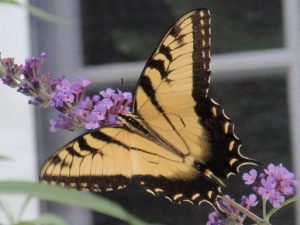 Tiger Swallowtail – Papilion
Tiger Swallowtail – Papilion
• Libellula (Dragonflies),
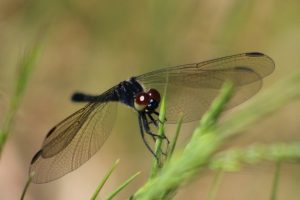 Dragonfly – Libellula
Dragonfly – Libellula
- Ephemera (Mayflies – Greek for short lived),
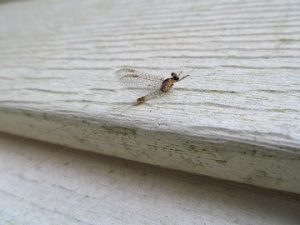 Mayfly – Ephemera
Mayfly – Ephemera
• Hemerobius (Lacewings – Greek hemera = ‘day’ + bios = ‘life'[ref: 1]),
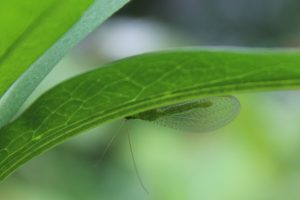 Green lacewing – Hemerobius
Green lacewing – Hemerobius
• Panorpa (Scorpionflies – Panorpa: Greek pan ‘all’ + horpo/harpe ‘sickle or a bird of prey’ Ref: 3 and 5] — may refer to the sickle-shaped male terminalia or to the beak),
• Raphidia (Snakeflies – Raphid is Greek for needle. [ref: 2]
• Apis (Honeybees – Latin),
• Ichneumon (a wasp – in Greek ichneúmōn means tracker [ref: 1]),
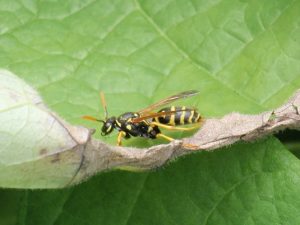 Yellow jacket, Ichneumon
Yellow jacket, Ichneumon
and
• Musca (Flies – From Latin musca ‘a fly'[ref: 1]).
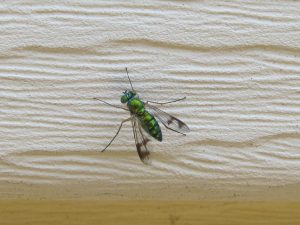 Fly – Musca
Fly – Musca
One can see Linnaeus’s thinking. It makes sense. Look at the pictures. All of these insects have wings without any wing coverings and with strong veins. Most of the names are descriptive. Many of these names are still in use; some for a genus name and some for the current family level.
In Linnaeus’s grouping of insects under the class Angioptera, his grid specifically referencing butterflies genus reads as follows:
- Papilia. Rostrum spirale. Alae 4. Papilio alis erectis.
- Psyche — planis.
- Phalaena — compressis.
For the genus Papilio, he noted as general characteristics: Rostrum (mouth parts) spirale (spiral referring to the coiled proboscis of the butterflies and moths). Alae 4 (4 wings). Papilio alis erectis translates to butterflies with erect wings. Psyche is named after the Greek Goddess of the soul. The Greeks believed butterflies were departed people. I suspect that the three dots in the description are used instead of repeating the word “alis.” Planis translates to flat, so butterflies that hold their wings flat. Finally, Phalaena (Greek for moths [ref: 4]) -– compressis (compressed, restrained, repressed) possibly referring to the plain coloration of most moths, but who knows. There are no other clues.
By the time the tenth edition of his book is published, Linnaeus has firmly implemented the binomial naming system and the book now is two volumes containing 835 pages just for the animals. He “ordinis,” Latin for Orders of which he calls one group Lepidotera – scaly wings and stopped using Angioptera. He restricts Lepidoptera to three genus. He has changed the name of the Psyche to Sphinx. He also now uses the antenna as the key separator as shown below.
III. LEPIDOPTERA.
203. PAPILIO Antennae extrorsum crassiores. Alae erectae. Antenna outwards thickness. Wings erect.
204. SPHINX Antennae medio crassiores.Antenna medium thickness.
205. PHALAENA Antennae introrsum crassiores. “Antenna “to within, inwards internally” thickness.
I am not sure I understand his thinking. Butterflies have slender and usually clubbed shaped antenna—thickened on the outer tip—maybe. Sphinx moths have long antennae also thickened at the tip, but not really feather antennae, so not very thick—maybe medium thickness. Moth antennae are vary variable, but many are very feathery or at least in the males, hardly thin as Linnaeus seems to be implying. By visiting the type species for this grouping, a moth Linnaeus called Phalaena typica, the image shows it does has very thin antenna, certainly not a characteristic of most moth species. The separation between moths and butterflies was not understood well at this time, so his collection in each of his genus is actually a mix of moths and butterflies.
It is amazing how a simple question can lead to a lot of detailed research. I had to indulge my curiosity on how animals received their names and how Linnaeus in particular picked names. From the few clues he provided, I have tried to discern his intentions. Since much of what Linnaeus did is out of date and no longer in use, this is purely for the pleasure of knowing and the challenge of learning. This all started out when I noticed a trend in the scientific names of many butterfly species. Understanding the origin of s scientific name can make it easier to remember and can reveal some interesting background. Soon, I will post a blog that should be less technical, more interesting, and certainly mythical on his choise of butterfly names.
I hope you found some enjoyment in tracing a little history.
Some references:
http://www.biodiversitylibrary.org/item/15373#page/2/mode/1up – Digital copy of Linnaeus’s 1735 book.
- Borrer, Donald J. Dictionary of Word Roots and Combining Forms. Mayfield Publishing Company, Palo Alto, CA, 1960.
- https://en.wikipedia.org/wiki/Snakefly
- https://www.merriam-webster.com/dictionary/Panorpa
- http://www.nhm.ac.uk/research-curation/research/projects/butmoth/search/GenusDetails.dsml?NUMBER=22525.0
- Webster’s New Universal Unabridged Dictionary 1983

